Growing lemongrass indoors with hydroponics is a fun and easy project!
Start by taking cuttings from healthy lemongrass plants. Cut a piece about 6 inches long and place it in water. Let it sit until you see roots start to grow.
Once the roots are ready, move the cutting to a hydroponic medium. Make sure your setup gets 12 to 14 hours of bright light each day. It’s also important to keep the pH level between 6.0 and 7.0.
Water the plants using a pump that runs every 15 minutes. Check the nutrient levels, too! You want about:
- 150 ppm of nitrogen
- 50 ppm of phosphorus
Don’t forget to trim the tops of the plants regularly. This helps them grow bushier.
Lastly, keep an eye out for pests. There’s a lot more to learn to grow lemongrass successfully.
Feel free to explore more tips and tricks to get the best results!
By following these steps, you can easily grow lemongrass indoors using hydroponics! Enjoy your gardening!
Key Takeaways
- 1. Start with Cuttings: First, take some lemongrass cuttings and place them in water. Make sure the roots are underwater. Change the water regularly to help them grow.
- 2. Move to Hydroponics: After about 2-3 weeks, when the cuttings have roots, it’s time to move them to a hydroponic setup. This will help them grow even better.
- 3. Watering Schedule: Set up a pump to water the plants every 15 minutes. This keeps the roots damp and helps avoid root rot.
- 4. Lighting Needs: Your lemongrass needs 12-14 hours of light each day. Use full-spectrum light and aim for an intensity of 200-250 µmol/m²/s for mature plants.
- 5. Check Nutrients and pH: Keep an eye on the nutrients and pH levels. The pH should be between 6.0 and 7.0 to help the plants grow strong and healthy.
Benefits of Growing Lemongrass
Growing lemongrass indoors has many great benefits. It can make your meals healthier and fill your home with a refreshing smell.
One big plus is that lemongrass is packed with antioxidants and vitamins. These nutrients help keep you healthy. Adding fresh lemongrass to your dishes can boost your immune system and help with digestion. This means it can ease tummy troubles and help you feel regular.
Lemongrass also helps reduce stress, which is good for your mental health. It’s a wonderful choice for your indoor garden.
Another advantage is that lemongrass acts as a natural bug repellent. It can keep unwanted insects away, making your home more comfortable.
If you’re new to gardening, lemongrass is a great option. It’s easy to care for and grows quickly. This means you can enjoy the benefits of growing it without too much effort.
Propagation Techniques
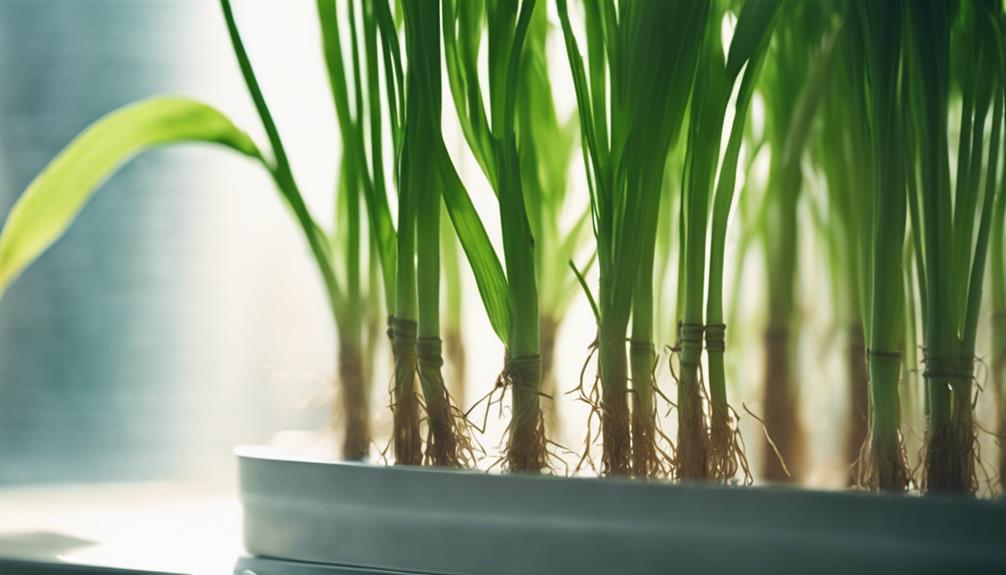
When you’re ready to grow lemongrass, start with fresh stalks from the grocery store. Make sure they’ve healthy roots and bulbs.
A great way to begin is by using the water propagation method. This is perfect for beginners!
Just take the stalks and put them in a glass of water. Keep an eye on them, and you should see new roots starting to grow in about 15 days.
Don’t forget to change the water regularly. This keeps it clean and helps the lemongrass grow healthy and strong.
Grocery Store Stalks
If you want to grow lemongrass, it’s really easy! Just grab some fresh stalks from the grocery store. Here’s what you need to do:
- Get a Container: Find a container and fill it with water. Make sure the bulb ends of the stalks are in the water.
- Find a Sunny Spot: Place the container in a sunny area. This will help the roots grow. You should see roots starting to form in about 15 days!
- Change the Water: Remember to change the water regularly. This keeps it fresh and helps the roots develop better.
- Watch the Temperature: Keep the temperature between 70°F and 85°F. A warm environment helps the lemongrass grow.
- Need Light: Make sure the stalks get enough light. This is important for strong growth.
After about 2 to 3 weeks, if you see good roots, you can move the stalks to a hydroponic medium. This is a special way to grow plants without soil. It gives your lemongrass more nutrients, helping it grow even better.
How to Propagate Lemongrass in Water
Propagating lemongrass in water is a simple and fun way to grow your own plants. Here’s how to do it:
- Choose Healthy Stalks: Start by picking fresh lemongrass stalks that have healthy roots. These will grow best.
- Prepare the Container: Take a clear container and fill it with water. Make sure the container gets plenty of sunlight. This helps the roots grow strong.
- Submerge the Stalks: Place the stalks in the container, making sure to put the roots in the water. The water shouldn’t cover the cut ends of the stalks, as this can cause them to rot.
- Change the Water Regularly: Change the water every few days. This keeps it fresh and helps the roots develop properly.
- Watch for Root Growth: Usually, you’ll see roots start to grow within 10 to 15 days. This means your lemongrass is on its way!
- Keep It Warm: For the best growth, keep your container in a warm spot. Aim for temperatures between 70°F and 85°F.
- Transplant When Ready: When the roots are about 2 to 3 inches long, you can move your lemongrass to a hydroponic medium. This helps your plant grow even better.
Hydroponic Growing Methods

Growing lemongrass with hydroponic systems has some great benefits, especially if you’re short on space indoors.
Keep in mind that you’ll need to use the right nutrient solutions.
Plus, using hydroponics lets you grow lemongrass all year long.
That means you can always have fresh lemongrass ready for your cooking!
Advantages of Hydroponic Systems
Hydroponic systems make it easier to grow lemongrass indoors.
One big advantage is that you can grow it all year round. No more worrying about the seasons! You can enjoy fresh lemongrass anytime you want.
Another benefit is that hydroponics helps reduce pests that come from the soil. This means a cleaner space for your plants and healthier growth.
With hydroponic systems, you have great control over what your plants eat. You can use special nutrient solutions made just for lemongrass. This helps your plants grow faster and stay healthy. You won’t have to worry about them missing out on important nutrients like you might with regular soil gardening.
If you’re short on space, hydroponics is perfect for you! You can use vertical gardens to grow more lemongrass in a smaller area. Plus, systems like Grow Mesh help with air circulation, which keeps the roots healthy. This means your plants can grow quicker than if they were in soil.
In short, hydroponic systems offer many benefits for growing lemongrass, making it a smart choice for indoor gardening!
Essential Nutrient Solutions
Essential nutrient solutions are super important for growing lemongrass in hydroponic systems. To help your plants grow well, you’ll need to provide them with certain nutrients at the right levels:
- Nitrogen: 150 ppm
- Phosphorus: 50 ppm
- Potassium: 200 ppm
- Calcium: 100 ppm
Make sure to check the pH level regularly. It should stay between 6.0 and 7.0 to ensure that the nutrients can be used by the plants.
Besides the nutrients, keeping the right amount of moisture is key. You should have a water pump that runs every 15 minutes. This helps keep the hydroponic environment steady.
Using Grow Mesh systems can improve the air around the roots. Good air is really important for healthy roots in hydroponics.
Light is also crucial for growth. Mature lemongrass needs a light intensity of 200-250 µmol/m²/s.
Care and Maintenance
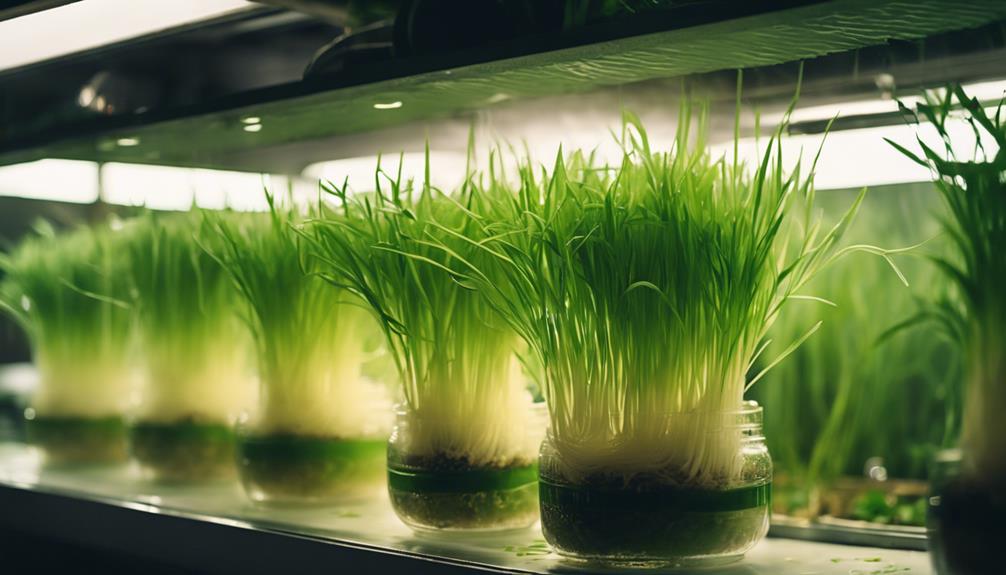
Taking care of your hydroponic lemongrass is super important. To keep it well-hydrated, make sure your water pump runs every 15 minutes. This will help your plant stay healthy and grow well.
Regularly trim the tops of your lemongrass. This helps the plant grow bushier and produce more.
Make sure your setup gets 12-14 hours of light each day. The light should be strong, around 200-250 µmol/m²/s, to help your lemongrass thrive.
Keep an eye on the pH level of your nutrient solution, too. It should stay between 6.0 and 7.0. This is crucial for strong roots and getting the nutrients the plant needs.
Don’t forget to check for pests or diseases. Even indoor hydroponic systems can have these problems. Finding and fixing issues early is key to keeping your lemongrass healthy.
Troubleshooting Common Issues
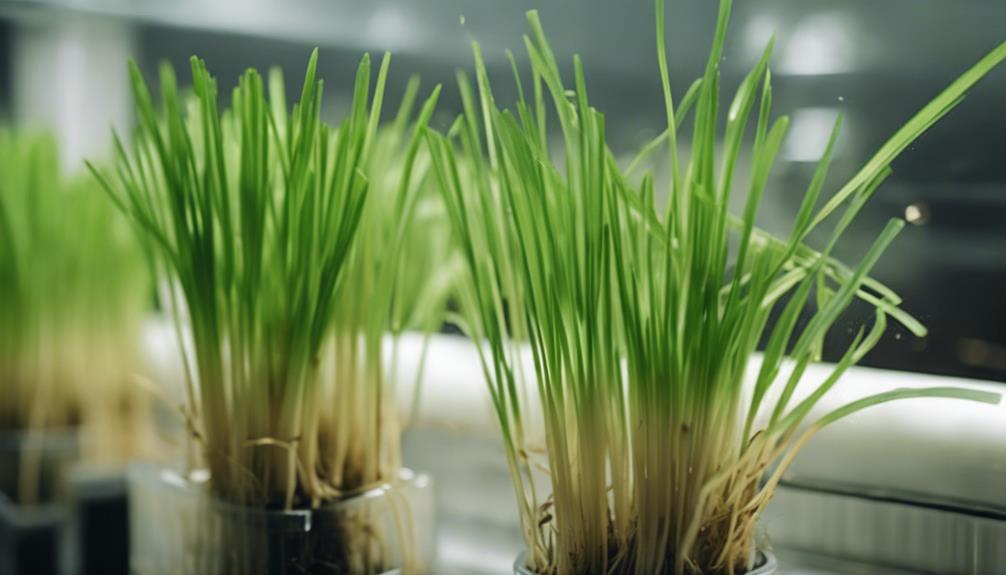
When you see brown leaves on your lemongrass, it’s important to check the water and nutrients. This will help you find out what might be causing the problem. Fixing these issues quickly can stop further damage to your plant.
Here are some simple steps you can take:
- Check the water: Make sure your hydroponic system has enough water. Too much water can cause root rot.
- Adjust the nutrients: Regularly test and change the nutrient levels to fit what your plant needs.
- Look for pests or diseases: Keep an eye out for bugs or signs of sickness in your plant. Catching these early can save your lemongrass.
- Make sure there’s good drainage: Check that your pots drain well. Stagnant water can hurt the roots.
Germination Steps
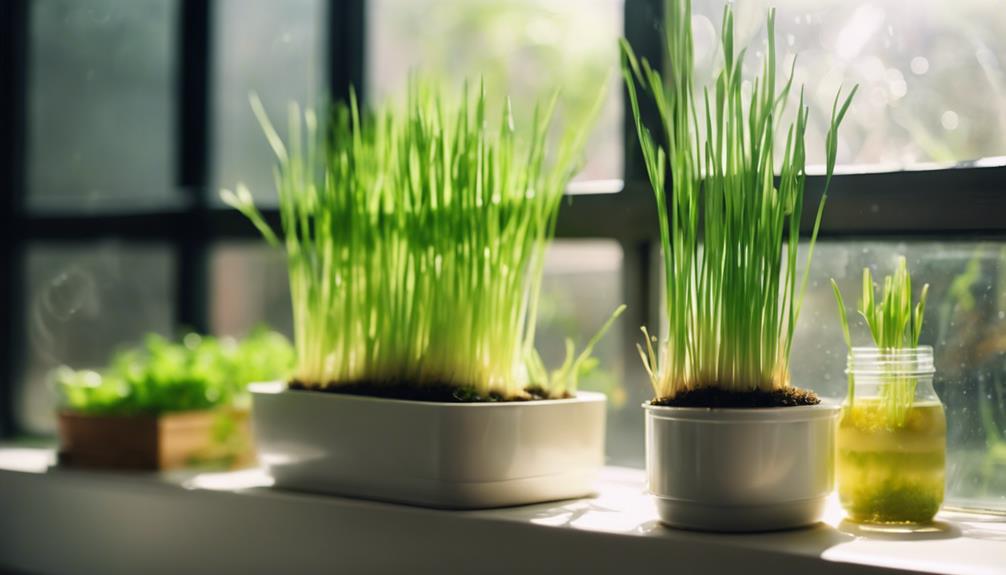
To grow lemongrass indoors from a cutting, start by getting a healthy piece with a few nodes. These nodes are important for the plant’s growth.
Next, use the water propagation method. This means you’ll put the cutting in water to help it grow roots.
Cutting Preparation Techniques
Preparing a healthy cutting from a mature lemongrass plant is important for it to grow well. Here’s how to do it right:
- Choose a good plant: Pick a healthy lemongrass plant with strong roots.
- Make your cut: Use sharp scissors or a knife to cut a piece that’s at least 6 inches long. Focus on the bulb end of the plant.
- Submerge the cutting: Put the cut piece in a container of water, with the bulb end down. Make sure the water covers the bottom part but doesn’t drown the leaves.
- Change the water often: Every few days, change the water. This keeps it fresh and helps the roots grow better.
- Watch the roots grow: When the roots are about 2-3 inches long, you can move the cutting to a well-aerated hydroponic medium.
Water Propagation Method
After you’ve prepared your lemongrass cutting, it’s time to try water propagation. This method helps the roots grow strong.
First, place your cutting in a container filled with water. Make sure the roots are fully submerged, while the stalk stays above the water.
Next, find a spot for your container that gets indirect sunlight. This light will help the roots develop. You can expect to see roots starting to grow in about 15 days.
To help your lemongrass grow well, keep an eye on the conditions. The cutting needs 12-14 hours of light every day. This helps it stay healthy while the roots form. As the roots grow, they should reach about 2-3 inches long.
Once the roots are long enough, you can move the cutting to a hydroponic medium. This will support its growth and help it get the nutrients it needs.
Don’t forget to change the water in your container regularly. Fresh water keeps the roots healthy and prevents any bad smells.
Growing Process and Requirements

To grow lemongrass indoors and keep it healthy, it’s really important to give it the right amount of light. Your lemongrass needs 12 to 14 hours of full-spectrum light each day. Different stages of growth need different light strengths.
- When the lemongrass is just starting out, use a light strength of 150 to 200 µmol/m²/s.
If you’re using a hydroponic system to grow lemongrass, here are some things you need to keep in mind:
- Watering Schedule: Make sure to run the water pump every 15 minutes. This will keep the plants consistently moist.
- pH Level: Keep the pH level of the water between 6.0 and 7.0. This helps the plant absorb nutrients better.
- Nutrient Solution: Use a balanced nutrient mix that includes:
- Nitrogen: 150 ppm
- Phosphorus: 50 ppm
- Potassium: 200 ppm
- Calcium: 100 ppm
- Magnesium: 50 ppm
- Light Monitoring: Check the light levels regularly. This helps make sure the plants are getting enough light.
Planting Techniques for Lemongrass

To grow lemongrass indoors with hydroponics, being by picking healthy stalks that have full bulbs. First, put the stalks in water so they can grow roots. Once they’ve roots, you can move them to a hydroponic setup. Before planting, trim the tops of the stalks. This helps the plant grow new shoots and keeps it strong.
When choosing a hydroponic system, make sure it can keep the nutrient solution at a pH level between 6.0 and 7.0. This balance is important for the health of your lemongrass. Check the water levels and nutrient amounts regularly. Lemongrass loves steady moisture and nutrients.
Even though you won’t use potting mix in hydroponics, knowing what it has can help you create a nutrient solution that has the right ingredients.
Place your hydroponic system in a spot where it can get 12-14 hours of light each day. Good light helps your lemongrass grow better and produce more leaves.
Recommended Products

If you want to grow lemongrass indoors, there are some helpful products to consider. These tools will help your plants grow strong and healthy in a hydroponic system.
Here are some recommended items you might need:
- Miracle-Gro Hydroponic Fertilizer: This fertilizer gives your plants the right nutrients. The best mix is 150 ppm of Nitrogen, 50 ppm of Phosphorus, and 200 ppm of Potassium.
- Grow Mesh Hydroponic System: This system helps air move around and makes sure your plants get enough water and nutrients. This leads to quicker growth.
- pH Testing Kit: This kit is important for checking the pH level of your water. Aim for a pH between 6.0 and 7.0. This helps your plants absorb nutrients better.
- Hydroponic Grow Lights: Your plants need 12-14 hours of light each day. The lights should be full-spectrum and have an intensity of 200-250 µmol/m²/s for mature plants.
With these products, you’ll create the best environment for your lemongrass to grow!
Community and Resources
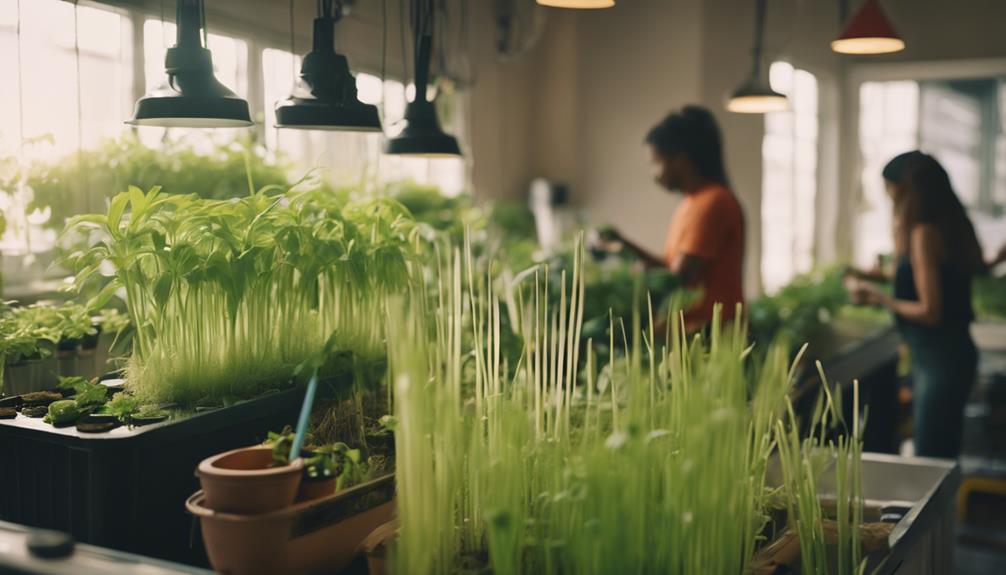
Joining online communities and using resources for hydroponic gardening can really help you grow lemongrass indoors.
Platforms like TikTok are great for finding tips, visual guides, and stories from other gardeners. Many influencers and gardening fans share helpful advice on the best hydroponic systems and methods, which is especially useful for beginners.
Being part of these communities can promote eco-friendly gardening and help you learn what you need to succeed in indoor hydroponics.
Can We Grow Lemongrass Indoors with Hydroponics?
Growing lemongrass indoors with hydroponics is a fun and rewarding way to garden.
Here’s a simple breakdown of what you need to know:
- Benefits: When you grow lemongrass this way, you can enjoy fresh herbs all year long.
- Propagation Techniques: Learn the best ways to start your plants. You can use cuttings or seeds to grow new lemongrass.
- Care Tips: Take good care of your plants. Make sure they get enough water, light, and nutrients.
- Troubleshooting: If you run into problems, fix them quickly. Don’t wait too long to address any issues.
- Recommended Products: Use the right tools and supplies to help your lemongrass thrive.
With a bit of knowledge and the right resources, you can easily grow this tasty herb. It will add flavor to your meals and make your home smell great.
Happy growing!
